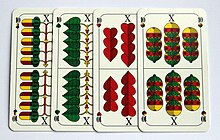

German-suited playing cards are a very common style of traditional playing card used in many parts of Central Europe characterised by 32- or 36-card packs with the suits of Acorns (Eichel or Kreuz), Leaves (Grün, Blatt, Laub, Pik or Gras), Hearts (Herz or Rot) and Bells (Schelle, Schell or Bolle). The German suit system is one of the oldest, becoming standard around 1450 and, a few decades later, influencing the design of the now international French suit system of Clubs, Spades, Hearts and Diamonds. Today German-suited playing cards are common in south and east Germany, Austria, German-speaking Switzerland, Liechtenstein, north Italy, Hungary, Czech Republic, Slovakia, Slovenia, Croatia, Bosnia, northern Serbia (Vojvodina province), southern Poland and central and western Romania.